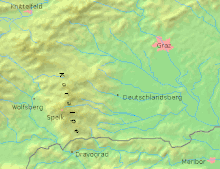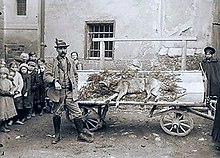Peasant fright (predator)
Bauernschreck is the name for (at least) one predator that killed hundreds of grazing animals and numerous wild animals in just a few months in 1913/14 in the border area between Styria and Carinthia (then Austria-Hungary ). After the attacks had largely ceased in December 1913, on March 5, 1914, a wolf was hunted down as a "peasant scare" near the Wildbachsattel on the Handalm . A memorial stone at this point commemorates the events of that time.
Attacks and countermeasures
The first attacks, namely on the Stubalpe , were reported in June 1913; Young and old animals of sheep and cattle as well as deer and foals were attacked. By September 4, 1913, 94 cattle and 380 sheep had been killed, and in the affected region “large areas were completely empty”. Some animals were attacked in the neck, others in the thigh. The injuries to some animals suggested that "the predator would attack its victims from an elevated point". Since practically no blood was found at the site of the attack on a calf, it was assumed that the predator licked the blood. An almost circular paw print discovered there had a diameter of 9.5 centimeters; elsewhere, step seals with a diameter of 12.5 to 13.5 centimeters were measured at attack sites. A killed deer, like numerous other attacked animals, had cracks from claws; a deer's head was missing.
The damage attributed to one or more predators (mostly described as a large wolf) was so great that it was assumed that a menagerie entrepreneur had released numerous predators, south of the Handalm they even wanted (on a steep mountain slope, the "chicken support") saw a lion and a tiger at Bad Gams. 170 gendarmes are said to have been stationed in the area and a large number of hunters tried to kill the animal. A piece of music called “The Hunt for the Peasant Fright” was performed and even the emperor is said to have been interested in the development of the hunt. The dead animal was stuffed, exhibited in a pavilion in the Graz industrial hall and later also in Vienna, it was kept in the Carinthian State Museum and was in the Lavanthaus Museum in Wolfsberg in 2018 .
Crisis teams and special commissions were set up, security police measures decided and bounties exposed. Parallels were seen with the fall of the Beast of Gévaudan , which was notorious in southern France from 1764 to 1767 for its attacks on people. Since children were considered to be at risk, school lessons were suspended for days; Children who lived in remote areas were exempt from teaching. The attempt was made to kill the attacker (s) with a great deal of personnel; even the military was involved. On July 31, 1913, 500 hunters, farmers and soldiers took part in a driven hunt.
In the Grazer Tagblatt on August 1, 1913, under the title “The predators in the Stubalpe area”, a call by the Styrian Hunting Protection Association was published, “to take part in rendering these predators harmless, to capture a rare trophy with the help of good tracking dogs and the peasant population to free them from these robbers ”. 40 different postcards with (mostly joking) motifs of the “Bauernschreck” were issued, a Bauernschreck liqueur was sold and an “Gasthaus zum Bauernschreck” was opened in Vienna.
Similar events took place in 1921 in the Burgerwald near Kindberg , where on April 23, 1921, a 40-man battue group set out to hunt a predator that was hunted shortly afterwards.
Indications of the predator species
Because of the very different injuries to the animals killed, it was assumed that the attackers belonged to different species of predator, both from the cat and dog families . It was suspected that the attackers might be predatory animals that had escaped captivity. In July 1913, for example, a visitor to Schönbrunn Zoo reported to a zoo keeper that several predators had escaped from a traveling menagerie in Deutschlandsberg (Styria) on May 4, 1913: a lioness with two cubs, two hyenas and two wolves. The authorities then declared that there had been no menagerie in Deutschlandsberg for two years. However, research by the Grazer Volksblatt revealed evidence of the presence of a menagerie in the region concerned: In November 1912, a menagerie with three adult lions, two young lions, a hyena, a bear and two wolves was said to have moved from Bruck an der Mur to Eggenberg (Graz) moved and later traveled on by train to Marburg , where it was dissolved; In Eggenberg animals are said to have escaped from the extremely damaged cages, but were recaptured.
The Reichspost reported on September 10, 1913 that a rifleman had observed a lioness in the area and identified it on the basis of the following features: "a tail ending in a tassel, about two meters in length and a yellowish color of the coat". On September 27, 1913, the Znojmo weekly newspaper reported on further visual observations: “The view that the dreaded predator is a lion is penetrating more and more ... According to a military telephone message from the area of Breitenegg in Carinthia , a cat-like predator ... torn a two-year-old cattle The investigations of the gendarmerie have established that Mr. Franz Durl, an ... occasional Weidmann, passed the lion, which is about 150 centimeters long, on 17th d. At 5 p.m. I saw Hühnerstütze-Bärentalkogel creeping up to a distance of a few hundred paces on the Alpe. Likewise, Mr. Karl Holzer from Deutschlandsberg saw the lion on the same day in the same area at 7 a.m. at a distance of 200 meters. A third gentleman, a reliable pastoralist from the area, also saw the lion, but in another place on the same alp. ... The forest staff in the area address the predator as a big cat. ”On the other hand, two old wolves and later also young wolves were seen in the Stubalpen area on July 27th. In addition, attacks by poaching dogs on ungulates were not uncommon in the affected region.
A Styrian veterinarian sketched paw prints of two animals, which were interpreted as the footsteps of a lioness and her cub. After shepherds had observed two large yellow-brown animals in the second half of September, step seals were found in the damp ground, from which plaster casts were made. The casts were examined by the director of Schönbrunn Zoo, who made comparative impressions of large cats of different species as well as of a hyena and a wolf in the zoo by letting the zoo animals walk over clay. He concluded the tracks were most likely from a puma .
From December 1913 at the latest, individual sneaked deer and hares were found only occasionally, at intervals of several weeks. On March 5, 1914, a male wolf that had been shot the day before and weighed 38 kilograms was shot on the Koralpe and presented as a "peasant fright" without any evidence that he had had anything to do with the attacks. The animal had been shot by the hunter of the Henckel-Donnersmarck county, Paul Steinbauer, and the next day it was killed by the Frantschach factory director Max Diamant. The date "4. March 1914 “on the memorial stone refers to the first shot by the hunter, not to the shooting. The prepared wolf was exhibited in the museum in the Lavanthaus in Wolfsberg (Carinthia) in 2018.
Individual evidence
- ↑ Werner M. Thelian: Der Bauernschreck. The true story of a newspaper sensation. Kindle Edition, 2nd edition 2014, p. 25.
- ↑ a b c d [1] Reichspost, September 10, 1913, p. 6.
- ↑ a b [2] Illustrierte Kronen Zeitung , September 12, 1913, p. 2.
- ↑ [3] Grazer Tagblatt , June 23, 1913, p. 4.
- ↑ Werner M. Thelian: Der Bauernschreck. The true story of a newspaper sensation. Kindle Edition, 2nd edition 2014, p. 79.
- ↑ Herbert Kriegl: “The peasant fright.” A story that happened a hundred years ago. In: Weekly newspaper Weststeirische Rundschau . November 22, 2013. Volume 86, No. 47. ZDB -ID 2303595-X page 9.
- ^ Beast from the Koralm, Bauernschreck. In: Weekly newspaper Weststeirische Rundschau . August 11, 2017. Volume 90, No. 32. P. 9.
- ↑ a b c d e Robert Price : The great wolf hunt. A hunt as a major tourist event. In: 111 gruesome places in Styria that you have to see. Verlag emons :, Graz 2018. ISBN 978-3-7408-0445-9 . P. 26.
- ↑ Werner M. Thelian: Der Bauernschreck. The true story of a newspaper sensation. Kindle Edition, 2nd edition 2014, p. 7 ff.
- ^ Grazer Tagblatt Friday, August 1, 1913, p. 3.
- ↑ Werner M. Thelian: Der Bauernschreck. The true story of a newspaper sensation. Kindle Edition, 2nd edition 2014, pp. 89 ff.
- ^ [4] Znaimer Wochenblatt, September 27, 1913, p. 8.
- ↑ Werner M. Thelian: Der Bauernschreck. The true story of a newspaper sensation. Kindle Edition, 2nd edition 2014, p. 239.
- ↑ Werner M. Thelian: Der Bauernschreck. The true story of a newspaper sensation. Kindle Edition, 2nd edition 2014, pp. 159 ff.
- ↑ Werner M. Thelian: Der Bauernschreck. The true story of a newspaper sensation. Kindle Edition, 2nd edition 2014, p. 191 ff.
- ↑ [5] Unterkärntner Nachrichten, March 11, 1914, p. 1 ff.
Web links
- Museum in the Lavanthaus
- Robert Preis: Years of chasing after the "Bauernschreck" Kleine Zeitung Styria, May 15, 2016
- Alexandra Kofler: The Beast from the Koralm Kleine Zeitung, March 29, 2015


